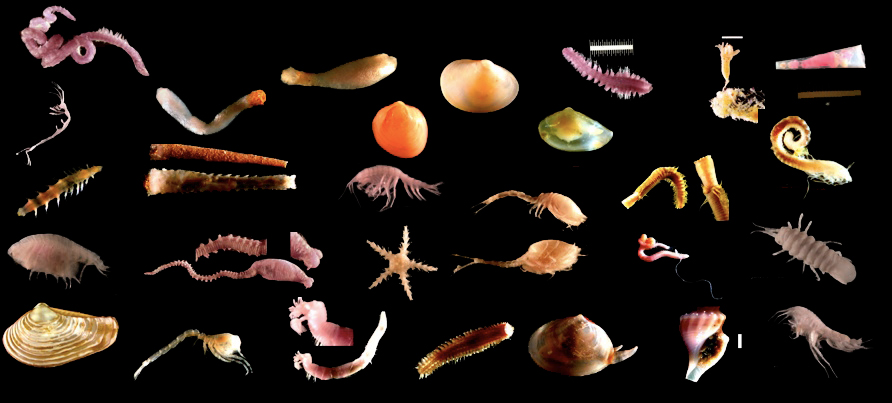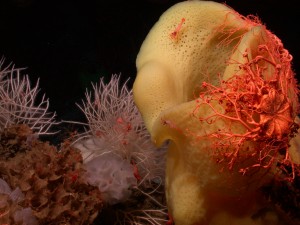 Discerning the processes influencing geographic patterns of species occurrence and coexistence remains one of the central goals of ecology and marine biology, directly speaking to the conservation of biodiversity. I seek to characterize the myriad of processes that interact to yield intricate biodiversity and biogeographic responses.
Discerning the processes influencing geographic patterns of species occurrence and coexistence remains one of the central goals of ecology and marine biology, directly speaking to the conservation of biodiversity. I seek to characterize the myriad of processes that interact to yield intricate biodiversity and biogeographic responses.
- One of the most well-known, deep-sea phenomena is the peak in benthic diversity between 1500-2500 m. Depth mirrors a gradient of rapid environmental change, e.g. carbon flux, currents, sediment, but how these factors generate bathymetric diversity patterns remains an outstanding question. My work demonstrates when species richness is highest, species become increasingly m
 ore ecologically and morphologically ‘packed’ into the community and differs significantly from random assembly processes (McClain et al. Evolution 2004). This contrasts with a scenario in which high species diversity occurs through a greater range of novel ecologies, morphologies, and functional groups. This suggests intermediate depths do not afford a broader range of niches rather species more finely subdivide them.
ore ecologically and morphologically ‘packed’ into the community and differs significantly from random assembly processes (McClain et al. Evolution 2004). This contrasts with a scenario in which high species diversity occurs through a greater range of novel ecologies, morphologies, and functional groups. This suggests intermediate depths do not afford a broader range of niches rather species more finely subdivide them. - My ongoing research focuses on diversity processes in deep submarine canyons, seamounts, and ridges, some of the ocean’s most pervasive features.
- Canyon topography creates habitat heterogeneity by, among many things, altering patterns of organic input. Areas of high carbon flux attract megafauna, increasing bioturbation and disturbance, and radically altering the composition and diversity of macrofauna. This work addresses the conundrum why diversity in macrofauna is low at higher productivities, e.g. shallow depths, in the deep-sea benthos and indicates the importance of cascading diversity processes (McClain and Barry, Ecology, 2010).
- Seamounts appear to possess geographically wide-spread species shared among seamounts and continental margins, challenging previous paradigms of high endemism and low connectivity. Despite the lack of endemic species, seamount communities might be structurally different and potentially serve as a source of larvae for suboptimal, non-seamount habitats (McClain, J Biogeography, 2007; McClain et al. PLoS One, 2009; McClain et al. Marine Ecology, 2010; McClain and Lundsten, Marine Ecology, 2014).
 My current work also focuses on species turnover across spatial scales from oceans to microhabitats. In an invited review, a coauthor and I examined the concept of ‘everything is everywhere’ in the deep sea (McClain and Hardy, Proc B, 2012). Despite immense capability for larval dispersal and overall greater range sizes of species, the biogeography of the deep sea is defined by dispersal barriers that are permeable and variable through time. At smaller scales, I am utilizing remote operated vehicles to quantify turnover in the deep-sea benthos at an often-ignored scale (1m-<1km). Preliminary work (McClain et al. MEPS, 2011) indicates a remarkable degree of spatial patchiness in faunal distributions at scales less than 0.5m to greater than 100m, reemphasizing that high beta-diversity of the deep sea occurs at multiple scales. The importance of heterogeneity in carbon availability for generating these small scales also occurs over oceanic distances (McClain et al. Proc B 2012).
My current work also focuses on species turnover across spatial scales from oceans to microhabitats. In an invited review, a coauthor and I examined the concept of ‘everything is everywhere’ in the deep sea (McClain and Hardy, Proc B, 2012). Despite immense capability for larval dispersal and overall greater range sizes of species, the biogeography of the deep sea is defined by dispersal barriers that are permeable and variable through time. At smaller scales, I am utilizing remote operated vehicles to quantify turnover in the deep-sea benthos at an often-ignored scale (1m-<1km). Preliminary work (McClain et al. MEPS, 2011) indicates a remarkable degree of spatial patchiness in faunal distributions at scales less than 0.5m to greater than 100m, reemphasizing that high beta-diversity of the deep sea occurs at multiple scales. The importance of heterogeneity in carbon availability for generating these small scales also occurs over oceanic distances (McClain et al. Proc B 2012).